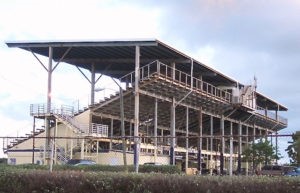The Randall “Doc” James Racetrack is getting back on track after a five-year delay, according to officials from VIGL Operations, speaking at a recent Coastal Zone Management Committee meeting.
Committee member Kai Nielsen raised concerns with the VIGL officials about whether they had taken into account the “dynamic” erosion on the South Shore just south of the racetrack. He said recent research and photo documentation showed a large amount of shoreline depletion since 1954. According to Nielsen, the erosion began after the construction of the jetty at the then Hess Oil refinery.
CZM Director Marlon Hibbert said the Department of Natural Resources had commissioned the University of Virgin Islands to study shoreline erosion, and the resulting report was essentially complete and did show the South Shore of St. Croix with troublesome areas — especially around the area of the racetrack. He added that he expects that a new partnership with the National Oceanic and Atmospheric Administration will shed more light on the situation.
Benjamin Keularts, an environmental consultant who was the lead in the VIGL presentation requesting an extension of its CZM permit, said that any changes to the shore during the racetrack project would be restored, and any mangroves or trees removed would be replaced.
Chair Masserae Sprauve Webster said the erosion so close to the racetrack should be a “serious concern” for VIGL. Hibbert said the erosion may be a threat to the “investment of VIGL and the community.”
Jason Williams, general manager at VIGL Racing Operations, blamed the five-year delay first on a lawsuit filed by Southland Gaming and then COVID. The CZM staff apparently agreed, saying VIGL showed just cause for the delays and recommended the committee approve an extension. It approved an extension until December.
Keularts said VIGL (which also runs the casino at the Caravelle Hotel in Christiansted) would be submitting modifications to its plans in March and hoped to break ground six months after.
The modifications mean that the grandstands will be two-story instead of three. Nielsen asked Williams if local horsemen had been told about the modifications. Williams said they had and were agreeable to them. He explained that the modification came about because of financial considerations as well as the post-COVID atmosphere. He said attendees at races might feel more comfortable in open spaces instead of confined seating.






